Most of us are not blessed with a choice of soil. We’re stuck with what we’ve got. And it seems like wherever I move, I get stuck with clay. By comparison to the clay in my old garden, the soil at my home now seems almost ideal. But it’s clay nonetheless, and I’ve had to work diligently to upgrade the soil.
Not that the soil isn’t perfect (to be ecologically correct) for its intended use. My part of the county isn’t called the Big Woods without reason, and the clay soil in my back yard will grow some awesome oak, maple, poplar, and hickory, without special treatment of any kind. But try to kick a spade into the ground, and you’re asking for a sprained knee.
If you face a similar problem, don’t fret. Whether your soil has more or less clay than mine, so long as you understand what you’re working with and keep at it over the years, adding organic matter and treating the soil structure right, you can get the better of clay soils and enjoy a productive kitchen garden.
Testing for Texture
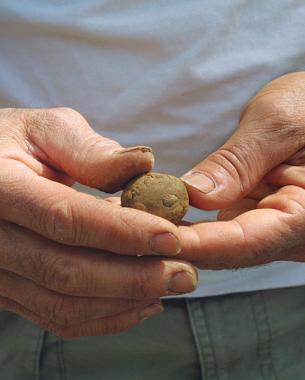
Photo/Illustration: Steve Aitken
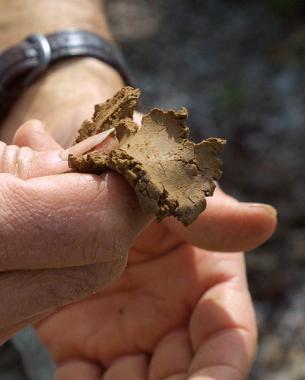
Photo/Illustration: Steve Aitken
A hand-texturing test is one method for determining the texture of your soil.
How long is your ribbon?
To determine the texture of your soil, measure the ribbon.
If your ribbon measures less than 1 inch long before breaking, you have loam or silt.
If your ribbon measures 1 to 2 inches long before breaking, you have clay loam.
If your ribbon measures more than two inches long before breaking, you have clay.
Related videos
Managing Soil Texture
Soil Testing
Related Article
How’s Your Soil Texture?
Clay is more promising than it’s cracked up to be
Before you try to manage the clay soil in your home garden, it helps to have a bit of background in soil mineralogy. The mineral fraction of a given soil consists of sand, silt, and clay particles. Clay particles are the smallest of the three, silt are intermediate in size, and sand, the largest. Clay particles, bound end to end and side to side in extensive planes, are stacked in a sandwichlike matrix and held together by electrochemical forces. This platelike stacking of horizontally arranged clay particles results in a large surface area.
Because individual clay particles are negatively charged, they have the capacity to attract and hold onto, or adsorb, positively charged elements (called cations) such as ammonium, potassium, calcium, magnesium, and other trace elements. Clay soils are relatively fertile because of this capacity to adsorb these important plant nutrients. Conversely, the single, uncharged sand particles in sandy soils lack the capacity to adsorb cations and thus they contribute very little to soil fertility.
Soil texture is an inherent property that you cannot change. Instead, direct your efforts toward improving soil structure.
Soil texture—The textural designation of a soil is determined by its relative portions of sand, silt, and clay particles, and indicates which of the three most influence the soil’s properties. Sand, silt, and clay soil properties are obviously dominated by those respective fractions. For example, clay soils (generally more than 40 percent clay) are often poorly drained. On the other hand, well-drained loam soils are mixtures of sand, silt, and clay in roughly equal proportions, and are well drained. A sandy loam, however, has much more sand and much less clay than does a clay loam.
Soil structure—Soil texture is an inherent soil property that you as a gardener cannot change (except through extreme interventions). Instead, you should direct your efforts toward improving soil structure. Soil structure is defined by the manner in which soil particles are assembled as aggregates. In clay soils, clay particles are typically arranged along a horizontal plane in a platelike structure. When these horizontal aggregations are stacked high and consolidated over time, they can be quite tight and sticky. Your aim in improving soil structure is to achieve a looser, more crumbly or granular structural aggregation. A soil with the latter structure has a friable consistency and good tilth.
Tilth—Tilth is the physical condition of the soil as it relates to ease of tillage, seedbed quality, ease of seedling emergence, and deep root penetration. A soil that drains well (yet has water-holding capacity), does not crust, takes in water rapidly, facilitates aeration, and does not make clods is said to have good tilth. And with the right management strategy, good tilth is achievable in a clay soil.
Clay demands short-term and long-range strategies
My initial management strategy centered on adding as much organic matter as deeply as I could, because, generally, the application of organic matter to soil improves both structure and tilth, and contributes to improvements in overall soil health.
My long-range management strategy attempts to build available organic carbon and humus and to promote nutrient cycling through regular applications of compost, manure, and other organic matter, the incorporation of cover crops as green manures, rotations that include grasses and legumes, and reduced tillage.
Organic matter builds soil tilth in a couple of ways. First, the organic matter coats soil particles, physically separating clay particles and aggregates from each other. Second, and more important, microorganisms that degrade organic matter produce byproducts called glomalin that bind individual clay particles together into aggregates. Particle aggregation in the topsoil reduces crusting, increases the rate of water infiltration, and reduces erosion and runoff.
Though my ultimate goal continues to be to increase soil organic matter content in the garden, I was less concerned initially with the numbers than I was with achieving the benefits described above. I understood that in southeastern soils, it would be very difficult to increase the percentage of organic matter in the soil very quickly.
For one thing, even large amounts of organic matter initially incorporated in the soil will rapidly break down. The organic matter fraction remaining may resist further degradation for years or even decades, but stable increases in this fraction, called the humic fraction or humus, occur very slowly. Thus, any increase in stable organic matter is necessarily a long-term goal.
Compost plays a key role
Composts are integral to my clay soil management plan. Because of the humified nature of compost and its low concentrations of oxidizable carbon and available nitrogen, compost is relatively resistant to further decomposition, and additions of compost to the soil over time can increase the soil’s organic carbon and humic matter content. I add compost not so much to provide nutrients as to provide stabilized organic matter that will improve the physical properties of the soil.
I’m fortunate to have a commercial compost supplier close by my home, so I can take advantage of very reasonable bulk pricing, along with a guaranteed chemical analysis that allows me to apply the compost at appropriate rates. There is absolutely no way I could have built a garden in my clay soil without the 16-cubic-yard tandem truckloads of compost that rolled onto my property. Moving that compost one wheelbarrow load at a time to my vegetable and flower beds is a weekend ritual. The incorporation of the compost into the soil has been more problematic.
During the initial, pre-garden phase of my soil improvement plan, I managed to break up 10 inches of hard-packed clay with endless swings of my trusty mattock. I spread compost over the surface of the beds an inch at a time and rototilled it in. I was careful not to work the clay when it was too wet, because clay worked wet can result in some tenacious clods, very reluctant in their willingness to ever come apart again. I tried to work the compost deep into the soil, and along with it, I added lime and phosphorus, the clay soil in my garden needing both. When surface-applied, neither of these materials moves down through the soil, so incorporation to ample depth is very important to permit roots to grow into the subsoil. After 3 to 4 inches of compost, I had the “raised bed” I wanted. I called it quits (for the time being) and planted my garden.
In the years since, I have been back through most of the beds several times with the mattock and more compost, trying to get organic matter and lime incorporated deeply to break up the “seal” that forms between amended and unamended soil, and to get my beds raised back up. It’s readily apparent that organic matter decomposes very quickly in the vegetable beds. In spite of all the amendments, the beds no longer seem “raised,” and there’s not much visible evidence of all the compost I’ve added. However, I can tell by the color, now a dark brown instead of red, and by the aggregation of the soil particles into a crumbly structure (of a kin with coffee grounds) that humus is accumulating.
Reworking a bed is always a fall practice when my rotation calls for fall-planted garlic or when potatoes or root crops will be planted early the following spring. I just can’t count on the beds being dry enough in spring to work the clay deeply without messing up the structure I’ve worked so hard to build.
Cover crops keep on giving
Along with adding compost, a second strategy for adding organic matter to my clay soil is cover cropping. I plant cover crops any time the beds in my garden would otherwise be unplanted or fallow. Fallow periods provide little additional organic biomass while allowing the decomposition of organic matter in the soil to continue. Cover crops provide me with a variety of services. They contribute to the improvements in soil structure that I described earlier. They reduce erosion and increase infiltration. And they can smother weeds and even suppress weed seed germination. Many cover crops will also suppress pathogenic nematodes, for example root knot nematode.
I take a machete and scalp the cover crop at the surface, killing it but leaving the biomass in place.
Leguminous cover crops can fix significant amounts of nitrogen for use by subsequent crops. Through symbiotic associations with legumes, Rhizobia bacteria convert atmospheric nitrogen into an organic form that legumes use for growth. How much fixation depends on the length of the growing season, the local climate, and soil conditions. Nonleguminous cover crops, principally grasses or small grains, do not fix atmospheric nitrogen, but can be effective in recycling residual soil nitrogen remaining in the root zone at season’s end, reducing leaching losses from the soil during the winter months. I often plant mixtures of grasses and legumes in the fall to reap the benefits of both. This past fall I planted hairy vetch and cereal rye, a proven mixture here. Crimson clover and rye or oats also do well in my area.
In mid-May, I become a terminator, literally putting these annual plants down to prepare the beds for summer vegetables. By then, the winter cover crops have provided my annual organic matter addition, as well as enough nitrogen fertilizer to grow my summer crops.
The less you disturb amended clay the better
Because of the many benefits that accrue to soil quality, it is clearly in your short-term interest to incorporate organic matter regularly and deeply, at least when beginning the process of whipping a clay soil into shape. Soil particle aggregation and aggregate stability, water holding capacity, drainage, nutrient retention, and plant root growth are all increased when organic matter is incorporated.
However, major losses in soil organic matter content can take place when the soil is inverted or mixed annually by tillage. Extensive tillage stimulates microbial activity (gives the little guys an appetite, so to speak), and the consumption of mass quantities of organic matter ensues. After your clay soil becomes more friable and you have provided a deep root zone for your garden plants, you should consider reducing tillage. Switching to a minimum-till system increases soil organic matter, soil organic carbon, total nitrogen, and soil microbial biomass carbon and nitrogen content, especially at the surface and in the top 2 to 4 inches. Because the soil remains undisturbed, fertilizers and other soil amendments do not become homogenized in the tillage layer. Plant feeder roots, therefore, tend to proliferate in the top 2 inches of fertile topsoil.
For a number of years now, I have been experimenting with no-till vegetable planting in the spring. I take a big knife (i.e., a machete), make sure there are bandages available nearby, and scalp the cover crop at the surface, killing it but leaving the biomass in place. I pull the residue apart just enough to dig a small hole with a trowel, drop in my tomato, pepper, or melon transplant, and pull the mulch back around the stem. I plant large seeds the same way, except that I leave a mulch-free window for sunshine to strike the seedling when it emerges. For small-seeded vegetables, I generally stir the soil a bit more and leave a strip of mulch-free surface above the seed.
Fruiting is delayed a bit because the soil is cooler for a time, but overall production is not sacrificed. The mulch reduces weed growth and prevents soil that may carry overwintering disease pathogens from splashing up on foliage. Infiltration of irrigation water and rainfall improves, as does soil moisture retention.
The residue decomposes much more slowly than if I tilled it in. Slower decomposition can result in more favorable timing of the release of nitrogen from the legume cover crop.
A few sticky situations
There are a few circumstances involving clay soils that merit special consideration. In the western states, some clay soils contain excessive sodium (these are known as sodic soils). The adsorption of sodium by clay particles can cause aggregated clay particles to “disperse,” or come apart, destroying friability and tilth. Typically, the remedy to this problem is the incorporation of gypsum (calcium sulfate) to provide soluble calcium that can replace the adsorbed sodium.
Unless gypsum is called for in a soil test report, however, it is rarely recommended as an amendment in clay soils. Most garden soils that have a proper pH (greater than 6.0) already contain adequate calcium.
Another special condition exists in those clay soils that shrink when dry and swell when wet. It is critically important that any tillage of these “expanding clay” soils (and other clay soils, too) occur only when soil moisture conditions are those that Baby Bear would like: “just right.”
To determine “rightness,” roll some soil between your palms into a ball about an inch in diameter. The moisture is right for tillage when a pinch between thumb and finger causes the ball of soil to fracture, break, or crumble into pieces.
Organic matter incorporated deeply by tillage is especially helpful in improving the soil structure of expanding clays.
A note of caution to gardeners who would attempt to improve clay soils by amending them with sand: This is a very risky business unless the sand (often incorporated as much as 50:50 by volume) is a very sharp sand. Otherwise, additions of sand to clay soil can create a cementlike creature that resists root growth and impedes the flow of air and water.

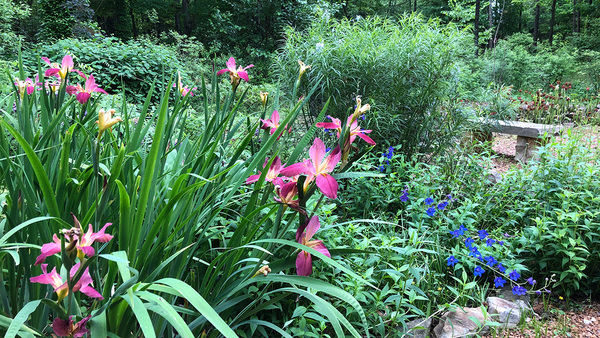

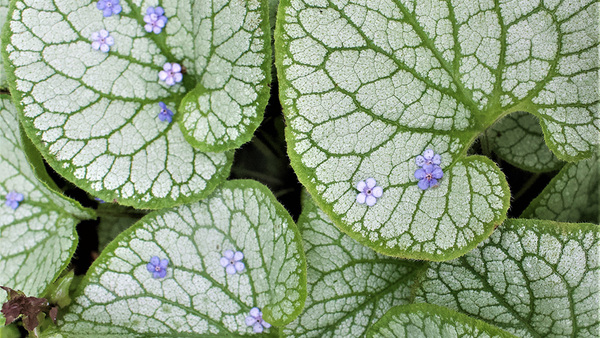


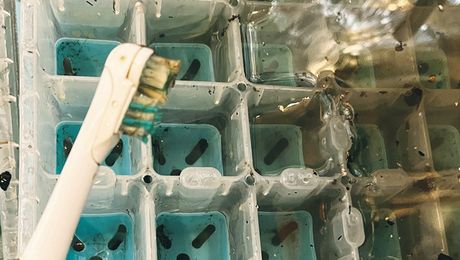










Comments
why is clay a soil particle whilst loamy soil is not a soil particle
Samuel: If I understand what I read correctly the word 'loam' characterizes the mixture as a whole.... Sort of in the same way 'chocolate milk' characterizes That mixture as a whole.... when you break down chocolate milk you don't get chocolate milk particles. You get instead all the components that combine to create the emulsion we know as milk plus all the ingredients that make up the chocolate... In the same way when you break down loam, rather than getting a loam particle you get all the components (clay, silt, sand, and organic matter) that combine in the right proportions to become loam...
should I add pet moss and black Maurine to my soil garden in the spring to help with the growing season
and will this help keep the weeds down?
Very interesting! Do you have any experience in using Hugelkultur in amending clay soils?
Hugelkultur is such a slow way to add organic matter that is not terribly useful for gardening on a human timescale. I don't consider it to be viable for non-timber crops.
I would be happy to reconsider this position if you have a link to a controlled trial of hugelkultur vs standard organic-practice raised beds.
Nice article.
I found a wonderful tool to use in place of a rototiller; a broadfork. It's a pitchfork on steroids. Found a quality one here: https://meadowcreature.com/ In FAQ, they have a list of vendors in several states and shipping options.
Also, great info on your page. Thanks!
$200.00 ? does it come with a laborer?
The Bully SuperFork from A. M. Leo is narrow but strong. Good for my heavy clay soil & substitute lawn aerator. At a sub 50$ price point, a good entry to the forking process. If I had a larger plot, beyond a few hundred squash ft, I might be tempted by a Broadfork or a Roebuck fork from new zealand.
how do you work with clay mixed with small rocks? Pile organic matter over it? dig out the rocks? I have an issue with rocks and clay. I don't even know where to start.
That's work that takes alot of time or years. If you want it done right away you need lots of help removing those rocks. If you can't afford the help, it's one patch at a time with removal. It's a constant battle every year. Remove those rocks where you want to put some plant beds that year. Then change the soil in those spots. Change your plant bed spots every year and clean out the rocks and amend the soil there. Don't forget to work the soil you already de rocked. Maybe put some cover crops there for now.
unfortunately my garden should have been a clay quarry tha'ts how bad my garden is and there is no easy fix like digging in compost unless you have a mini digger and a cement mixer because its far to heavy and dense there is no quick fix on my garden unless any body knows of a solution
Log in or create an account to post a comment.
Sign up Log in